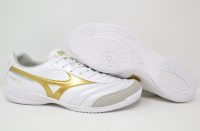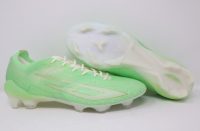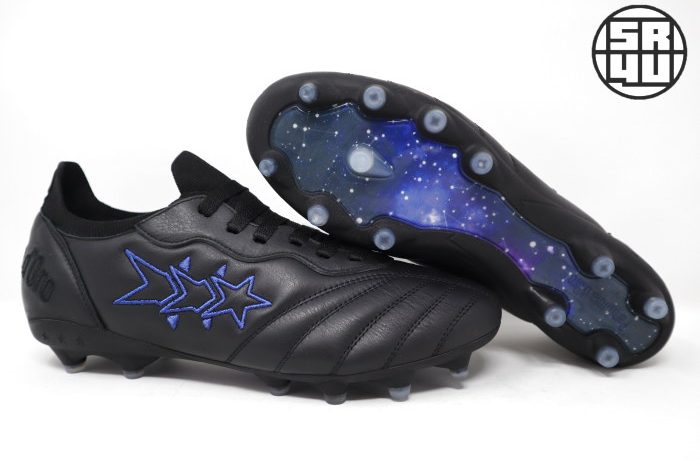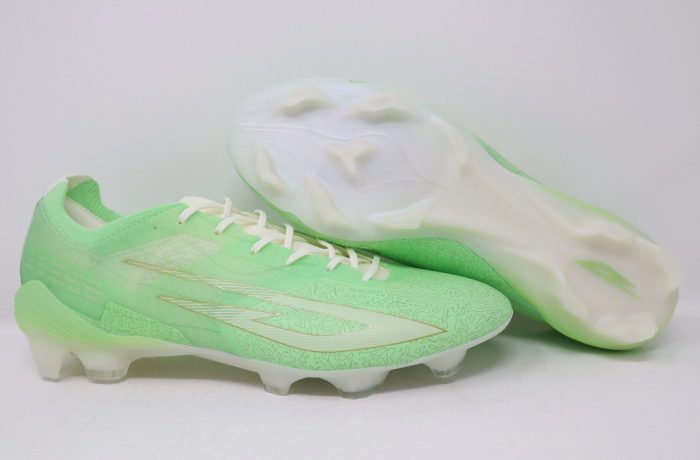<
I’ve always been hesitant to recommend a takedown model, just because its almost never the best option when it comes to performance, and often isn’t the best value for your money. You can often find older colorways or even older models that are top-end quality for the same price or cheaper than an in-line takedown model.
With that said, the Mercurial Veloce 2 changes things, and I must say that I’m really impressed with the quality of Nike’s takedown models as of late. The Nike Tiempo Legacy and Hypervenom Phatal, are both great options if you’re on a budget, and with the introduction of the Veloce 2, the same is true. It retails for $70 less than the top-end model above it, the Vapor 10, and has 95% of features and elements that you would get from this years Vapor. Given the design of the Vapor 10 this year, the Veloce 2, while technically a takedown model, might actually be more appealing, and equally as good when it comes to performance.
Comfort/Fit
The major design change coming from the Vapor 9 to the Vapor 10, is the introduction of the all-new one-piece upper. The upper is still made from ultra-thin Teijin synthetic, but instead of featuring a separate tongue through the middle of the boot, its seamless, kind of like the Superfly 4, but without the FlyKnit of course. Its unique, looks great and feels even better, and is the main “feature” that you miss out on with Veloce 2.
Instead of the upper being one-piece, the Veloce 2 is constructed the same way as Mercurial Vapors 1 through 9, which is totally fine. While I really like the one-piece design of the Vapor 10 for the seamless feel that it has to offer, many will argue that it wasn’t a necessary change to the constantly evolving Mercurial line, and they’d be right. If you haven’t had an issue with the layout of Mercurials up until this point, you won’t have any problems with the Veloce 2.
As far as the upper is concerned, you get the same ultra-thin Teijin synethetic found on the Vapor 10. As I talked about in my review of that shoe, this is by far the nicest variation of the Teijin synthetic that Nike has ever featured on a Mercurial. It’s as thin as it’s ever been, and surprisingly soft and flexible, which is also why the Vapor 10 and Veloce 2 go down as the most comfortable Mercurial models ever. Also, like you’ll find on the Vapor 10, you find an internal, fused on support cage that reinforces the entire upper, allowing the upper to as thin as possible, while still maintaining a very responsive and structured feel when making hard cuts and turns.
If compared to the previous Veloce model, every element of the boot has been dramatically improved, most notably the soleplate. The Veloce 2 features the same exact soleplate and stud pattern as the Vapor 10. Instead of being a standard TPU plastic like the original Veloce or even Glass Fiber like the Vapor 9, the new soleplate in made from Compressed Nylon. It looks very similar to what you get with the Hypervenom Phantom, but in comparison its much thinner, and significantly more flexible. It’s not as flashy as what we got from the MV9, but I prefer the more flexible, natural feel that it provides.
The new stud pattern sees Nike go back to a more “traditional” Mercurial layout. The firm ground variation now features four studs under the heel, getting away from only two studs found on the MV9, which makes for a much more stable feel, but at the expense of less aggressive traction. The layout in the forefoot also features a slightly modified layout, with the major difference being that there are a few extra studs, and the studs themselves are also a little wider in comparison to the MV9. Again, the trade off is better stability, for slightly less grip, but if you’ve worn Mercurials prior to the MV8, the MVX will provide a similar level of stability.
When it comes to fit, as you’d expect, the Veloce 2 has a tight fit. Again, something that seems to be a trend with takedown models is that they don’t fit as well as the top-end model, but that is not the case with the Veloce 2. Due to differences to the upper, the Vapor 10 and Veloce 2 do fit and feel different from each other, but what can’t be denied is that both shoes offer a great overall fit. Just like a Mercurial should, the Veloce 2 provides a one to one sensation on feet. The upper is thin, and wraps your foot perfectly like a second skin. Due to the tighter fit, the Veloce 2, or any Mercurial for that matter, isn’t really the best option for wider foot types. Also keep in mind that you won’t get much stretch, if any at all, out of the upper, even after the shoes are fully broken in. If you fit into previous Mercurial models, you’ll still fit into the Veloce 2.
As a side note, if you do have wide feet and absolutely must wear Mercurials, the Veloce 2 is available in a wide fit variation through the Nike iD customization service.
As far as sizing goes, the Veloce 2 runs true to size. I wore my usual size 9US for review, and the fit in the length was absolutely perfect. So, if you’re planning on ordering a pair, I would strongly recommend going for your normal size, or the same size as your previous Mercurials.
Weight
In terms of weight, the Veloce 2 is again very similar to the Vapor 10. In a size 9US, the Vapor 10 weighs in at 6.3oz, while the Veloce 2 comes in at 6.5oz. The difference is extremely minimal, and both in-hand or on feet, you simply can’t feel a difference in weight. They’re light, and that’s really all you need to know. It’s also worth mentioning that these are some of the lightest boots available within this particular price range.
Traction
Since the soleplate and stud pattern are exactly the same as the Vapor 10, the performance is also the same. The major change coming from the previous Mercurial line, most notably the Vapor 9, is that the stud pattern is now more stable, at the expense of being a little less aggressive.
For me, the biggest change is the heel studs. As opposed to having two studs, we’re back to four, maintaining the standard bladed shape. The two-stud layout was very aggressive and performed great when it came to digging into the ground, but weren’t the best when it came to stability. If you were playing on very well kept natural grass, firm ground playing surfaces, the stud pattern performed great, but if the ground is a little harder, which it often is for the average Joe, two studs in the heel doesn’t work so great. Going back to four studs allows for a little less grip, but significantly better stability, a change that I believe is better for most people and playing conditions.
In the forefoot, the changes are more of a tweak as opposed to a complete redesign. The FG layout is still very similar, with the major change being one extra stud. You’ll find two bladed studs on both the lateral and medial side of the forefoot, with one arrow shape bladed stud in the middle, one stud at the tip of the big toe and one additional stud just behind the one at the toe.
In terms of how the new layout impacts the overall performance, like I mentioned, the major difference is stability. The studs themselves seem to be a little less sharp and narrow this time around, so they don’t dig into the ground quite as easily. With that said, on most natural grass playing surfaces, even ones that are slightly softer, the overall performance is up to the usual Mercurial standards. You get solid grip when accelerating into a sprint, and rarely slip when making hard, quick cuts at high speeds. It keeps you on your toes, and just feels great.
To put it simply, if you’ve been a long time fan of the Mercurial series, you’ll enjoy Nike’s latest stud pattern.
Touch
As mentioned earlier, this is the thinnest Teijin synthetic upper ever featured on a Mercurial. Because of that, you get a touch on the ball that is as close to being barefoot as you can possibly be while still wearing shoes. As thin as it is, it’s also very soft and flexible, so it moves very nicely with the bend of your foot. It truly feels like a second skin on your feet.
In comparison to the Vapor 10, again you don’t get the one-piece upper, so you don’t get quite the same seamless sensation. With that said, the touch that it provides is still as good as it gets. If you enjoyed the feel of a previous Mercurial model, you’ll love what you get from the Veloce 2.
The second feature that you don’t get on the Veloce 2 in comparison to the Vapor 10 is ACC. All Conditions Control is Nike’s invisible wet weather control element, allowing for better grip on the ball in wet playing conditions. Its honestly a small thing that is a nice inclusion on Nike’s top-end models, but it isn’t one of those features that is going to make or break your experience with any Nike shoe.
Texturing is something that Nike played around with quite a bit on the MV9. Through its entire run, the MV9 was made available with either a smooth, leather grain texturing or the golf ball-like, dimpled texturing, called Speed Control. Both offered a slightly different feel, either more or less grip, and it’s was honestly nice to have the option to choose between the two variations. With the MVX, so far at least, there’s only one upper variation available. The Veloce 2 features its own unique texturing, that I would describe as the middle ground between the Speed Control texturing and the smooth option available on the MV9.
Described by Nike as a micro-texturing, from a distance, the upper comes across as completely smooth. Up close, it’s easy to see and feel the very subtle texturing across the entire upper, which provides a very slight grip on the ball. It reminds me a lot of the very subtle texturing found on Nike match balls. It’s nothing too crazy, but its just enough to give you some kind of grip on the ball, as opposed to just leaving it completely smooth, and at the same time doesn’t add any bulk to the upper.
When it comes to touch, the Veloce 2 provides a high-quality, traditional Mercurial playing experience, that is every bit as good as the Vapor 10. If your looking for a truly premium barefoot feel on a budget, this is a great option.
Shooting
Shooting the ball in the Veloce 2 is great, but nothing that I wasn’t expecting. The ultra-thin upper provides no extra padding between your foot and the ball, so you feel every part of the ball when shooting. The ultra-thin upper makes for a feeling of precision when curling and chipping the ball. The lack of cushion also creates a very responsive sensation when striking through the ball, something that I’m personally a huge fan of. The texturing also provides some minor grip on the ball, but nothing too crazy.
Another great aspect of the Veloce 2 when it comes to striking the ball is the lightweight, yet rigid feel when connecting with power. The upper stays tightly wrapped to your foot and the compressed nylon soleplate provides plenty of stiffness.
If you’ve worn Mercurials before, these will feel very familiar.
Protection
In order to achieve a premium barefoot feel for the ball, the upper has to be thin. The thinner the upper, the less protection that you’re going to have, and being that the MVX and Veloce 2 are some of the thinnest boots around, it shouldn’t come as a surprise that they provide very little protection. Aside from an internal plastic heel counter, the Teijin synthetic upper provides next to nothing in the way of impact protection. Should you get stepped on or take any kind of blow to the foot, you will feel every bit of that impact. To put it simply, if you value protection, stay away from the Mercurial line, but if you don’t mind leaving yourself exposed in exchange for a barefoot feel for the ball, then the Veloce 2 will do that better than almost any other boot around.
Durability
For a shoe as light as the Veloce 2, it feels surprisingly solid, something that can be said about most of the high-end Mercurial models to come out over the years. While the Teijin synthetic upper is thin, it still feels very durable, and strong enough to handle just about whatever is thrown at it. Going from 2 studs under the heel to 4 studs should also extend the lifespan of the boot for use on firm, natural grass playing surfaces. After 15 plus hours of wear time, I have had no issues whatsoever when it comes to the structural integrity and general wear of the Veloce 2.
This a boot that should easily get you through an entire season worth of play, if not much longer should you take good care of them.
Please keep in mind that the firm ground version of the Veloce 2, or any FG boot for that matter, is designed for use on firm, natural grass, and nothing else. Using any FG boot on artificial grass/turf will result in premature durability issues with your shoes. For the best durability, stick to using your boots on the playing surface that they are designed to be used on. Also keep in mind that the Veloce 2 is also available in soft ground and artificial grass stud variations, so you’re pretty much covered for all types of playing surfaces, its just up to you to buy the right model.
The Verdict
The launch of the 2014 Mercurial line has seen a lot of positive changes and new models. Most of the attention has been on the new Superfly 4, but the Vapor 10 and Veloce 2 also have a lot to offer when it comes to lightweight performance.
As a “takedown” model, the Veloce 2 is as similar to the top-end option as you can possibly get. It features the same soleplate, same stud pattern, same upper material and very nearly the same fit. You’re missing out on the one-piece upper and ACC feature, but those are elements that aren’t overly significant when it comes to how the Veloce 2 feels and performs, versus what you get from the Vapor 10.
For that reason, this is one of the first times ever where I can honestly recommend the Veloce 2 takedown model as a great alternative to the top-end Vapor 10. The Veloce 2 should be taken into consideration either because you don’t like, or aren’t sold on the one-piece design of the Vapor 10, although it is very good, or if you’re on a budget, but still want top-end performance. Its still very strange to me that Nike would put out a takedown model so similar to the Vapor 10, but I’m not complaining. The Veloce 2 raises the bar for what a takedown can and should be, so hopefully Nike continues this trend with future models and other brands follow.
If you didn’t get the message after all that, than here it is. The Veloce 2 is a great shoe, for a great price that I strongly recommend. Easily one of the best options in the $100-$130 price range.
| Comfort/Fit | 10 out of 10 |
| Weight | 10 out of 10 |
| Traction | 10 out of 10 |
| Touch | 10 out of 10 |
| Shooting | 9 out of 10 |
| Protection | 5 out of 10 |
| Durability | 8 out of 10 |
| FINAL SCORE | 62 out of 70 or 89% |








